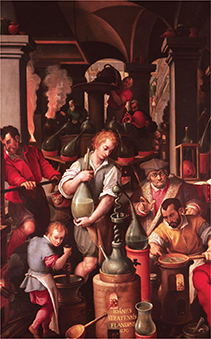10.3 Artificial Transmutation
Reading Focus
Key Concepts
 How do artificial transmutations occur?
How do artificial transmutations occur? How are transuranium elements produced?
How are transuranium elements produced?
Vocabulary
transmutation
transuranium elements
quark
Reading Strategy Monitoring Your Understanding Preview the Key Concepts, topic headings, vocabulary, and figures in this section. List two things you expect to learn. After reading, state what you learned about each item you listed.
What I Expect to Learn |
What I Learned |
|---|---|
a. |
b. |
c. |
d. |
During the Middle Ages, a number of people, like the ones shown in Figure 12, were obsessed with the idea of changing lead into gold. For centuries, these early scientists, known as alchemists, tried to use chemical reactions to make gold. But no matter how many recipes they tried, the alchemists only succeeded in making compounds that contained lead. What were they doing wrong?
Figure 12 This painting of an alchemist's laboratory was made around 1570. The alchemists failed in their attempts to turn lead into gold.

Nuclear Reactions in the Laboratory
The alchemists were trying to achieve transmutation. Transmutation is the conversion of atoms of one element to atoms of another. It involves a nuclear change, not a chemical change.
Nuclear decay is an example of a transmutation that occurs naturally. Transmutations can also be artificial.  Scientists can perform artificial transmutations by bombarding atomic nuclei with high-energy particles, such as protons, neutrons, or alpha particles.
Scientists can perform artificial transmutations by bombarding atomic nuclei with high-energy particles, such as protons, neutrons, or alpha particles.
Early experiments involving artificial transmutation led to important clues about atomic structure. In 1919, a decade after he discovered the atomic nucleus, Ernest Rutherford performed the first artificial transmutation. Rutherford had been studying the effects of nuclear radiation on various gases. When Rutherford exposed nitrogen gas to alpha particles, he found that some of the alpha particles were absorbed by the nitrogen nuclei. Each newly formed nucleus then ejected a proton, leaving behind the isotope oxygen-17.
Note that represents a proton. Rutherford's experiment provided evidence that the nucleus contains protons.





